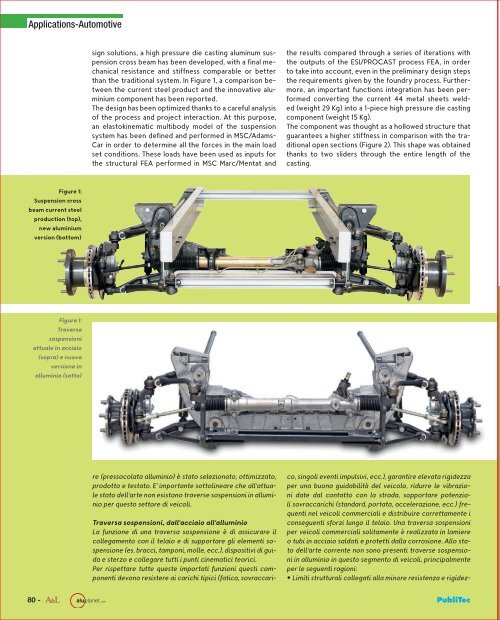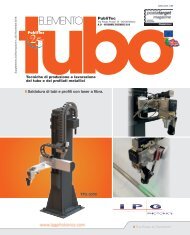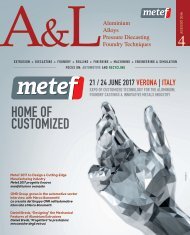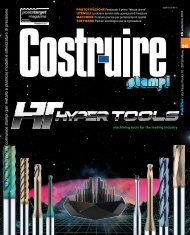AL_n5_OTTOBRE_2016
You also want an ePaper? Increase the reach of your titles
YUMPU automatically turns print PDFs into web optimized ePapers that Google loves.
0078-0082 3<br />
Applications-Automotive<br />
signsolutions,ahighpressurediecastingaluminumsuspension<br />
cross beam has been developed, with a final mechanical<br />
resistance and stiffness comparable or better<br />
than the traditional system. In Figure 1, a comparison between<br />
the current steel product and the innovative aluminium<br />
component has been reported.<br />
The design has been optimized thanks to a careful analysis<br />
of the process and project interaction. At this purpose,<br />
an elastokinematic multibody model of the suspension<br />
systemhasbeendefinedandperformedinMSC/Adams-<br />
Car in order to determine all the forces in the main load<br />
set conditions. These loads have been used as inputs for<br />
the structural FEA performed in MSC Marc/Mentat and<br />
the results compared through a series of iterations with<br />
the outputs of the ESI/PROCAST process FEA, in order<br />
to take into account, even in the preliminary design steps<br />
the requirements given by the foundry process. Furthermore,<br />
an important functions integration has been performed<br />
converting the current 44 metal sheets welded<br />
(weight 29 Kg) into a 1-piece high pressure die casting<br />
component(weight15Kg).<br />
Thecomponentwasthoughtasahollowedstructurethat<br />
guarantees a higher stiffness in comparison with the traditional<br />
open sections (Figure 2). This shape was obtained<br />
thanks to two sliders through the entire length of the<br />
casting.<br />
Figure 1:<br />
Suspension cross<br />
beam current steel<br />
production (top),<br />
new aluminium<br />
version (bottom)<br />
Figura 1:<br />
Traversa<br />
sospensioni<br />
attuale in acciaio<br />
(sopra) e nuova<br />
versione in<br />
alluminio (sotto)<br />
re (pressocolata alluminio) è stato selezionato, ottimizzato,<br />
prodottoetestato.E’importantesottolinearecheall’attualestatodell’artenonesistonotraversesospensioniinalluminio<br />
per questo settore di veicoli.<br />
Traversa sospensioni, dall’acciaio all’alluminio<br />
Lafunzionediunatraversasospensioneèdiassicurareil<br />
collegamentoconiltelaioedisupportareglielementisospensione<br />
(es. bracci, tamponi, molle, ecc.), dispositivi di guidaesterzoecollegaretuttiipunticinematiciteorici.<br />
Perrispettaretuttequesteimportatifunzioniquesticomponenti<br />
devono resistere ai carichi tipici (fatica, sovraccarico,singolieventiimpulsivi,ecc.),garantireelevatarigidezza<br />
perunabuonaguidabilitàdelveicolo,ridurrelevibrazioni<br />
date dal contatto con la strada, sopportare potenziali<br />
sovraccarichi (standard, portata, accelerazione, ecc.) frequentinelveicolicommercialiedistribuirecorrettamentei<br />
conseguentisforzilungoiltelaio.Unatraversasospensioni<br />
per veicoli commerciali solitamente è realizzata in lamiere<br />
otubiinacciaiosaldatieprotettidallacorrosione.Allostato<br />
dell’arte corrente non sono presenti traverse sospensioni<br />
in alluminio in questo segmento di veicoli, principalmente<br />
per le seguenti ragioni:<br />
• Limiti strutturali collegati alla minore resistenza e rigidez-<br />
80 - .com<br />
PubliTec





